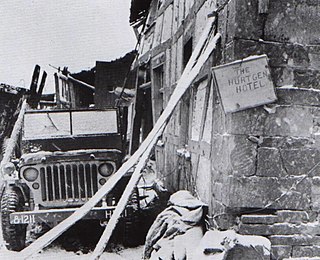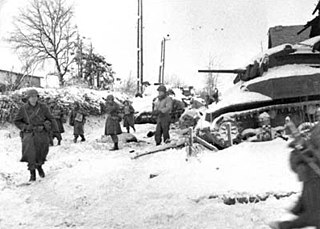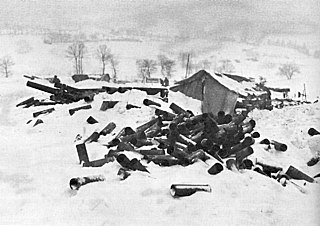Related Research Articles

The Battle of Hürtgen Forest was a series of battles fought from 19 September to 16 December 1944, between American and German forces on the Western Front during World War II, in the Hürtgen Forest, a 140 km2 (54 sq mi) area about 5 km (3.1 mi) east of the Belgian–German border. It was the longest battle on German ground during World War II and is the longest single battle the U.S. Army has ever fought.

The Battle of the Bulge, also known as the Ardennes Offensive, was the last major German offensive campaign on the Western Front during World War II. The battle lasted for five weeks from 16 December 1944 to 28 January 1945, towards the end of the war in Europe. It was launched through the densely forested Ardennes region between Belgium and Luxembourg. It overlapped with the Alsace Offensive, subsequently the Colmar Pocket, another series of battles launched by the Germans in support of the Ardennes thrust.

The Malmedy massacre was a German war crime committed by soldiers of the Waffen-SS on 17 December 1944 at the Baugnez crossroads near the city of Malmedy, Belgium, during the Battle of the Bulge. Soldiers of Kampfgruppe Peiper summarily killed eighty-four U.S. Army prisoners of war (POWs) who had surrendered after a brief battle. The Waffen-SS soldiers had grouped the U.S. POWs in a farmer's field, where they used machine guns to shoot and kill the grouped POWs; the prisoners of war who survived the gunfire of the massacre then were killed with a coup de grâce gun-shot to the head.

Tuinal was the brand name of a discontinued combination drug composed of two barbiturate salts in equal proportions.

The siege of Bastogne was an engagement in December 1944 between American and German forces at the Belgian town of Bastogne, as part of the larger Battle of the Bulge. The goal of the German offensive was the harbor at Antwerp. In order to reach it before the Allies could regroup and bring their superior air power to bear, German mechanized forces had to seize the roadways through eastern Belgium. Because all seven main roads in the densely wooded Ardennes highlands converged on Bastogne, just a few miles away from the border with neighboring Luxembourg, control of its crossroads was vital to the German attack.

The 99th Infantry Division briefly existed, but never deployed, in the closing days of World War I, was reconstituted as a reserve unit in 1929, was ordered into active military service in 1942, and deployed overseas in 1944. The 99th landed at the French port of Le Havre and proceeded northeast to Belgium. During the heavy fighting in the Battle of the Bulge, the unit suffered many casualties, yet tenaciously held its defensive position. In March 1945, the 99th advanced into the Rhineland, crossing the Rhine River at Remagen on March 11. After fighting in the Ruhr area, the unit moved southward into Bavaria, where it was located at the end of the war.

The 106th Infantry Division was a division of the United States Army formed for service during World War II. Two of its three regiments were overrun and surrounded in the initial days of the Battle of the Bulge, and they were forced to surrender to German forces on 19 December 1944. The division was never officially added to the troop list following the war, despite having been almost completely organized in Puerto Rico by 1948; subsequently, the War Department determined the division was not needed and inactivated the division headquarters in 1950.

Battle of the Bulge is a 1965 American widescreen epic war film produced in Spain, directed by Ken Annakin and starring Henry Fonda, Robert Shaw, Telly Savalas, Robert Ryan, Dana Andrews and Charles Bronson. The feature was filmed in Ultra Panavision 70 and exhibited in 70 mm Cinerama. Battle of the Bulge had its world premiere on December 16, 1965, the 21st anniversary of the titular battle, at the Pacific Cinerama Dome Theatre in Hollywood, California.

Amobarbital is a drug that is a barbiturate derivative. It has sedative-hypnotic properties. It is a white crystalline powder with no odor and a slightly bitter taste. It was first synthesized in Germany in 1923. It is considered a short to intermediate acting barbiturate. If amobarbital is taken for extended periods of time, physiological and psychological dependence can develop. Amobarbital withdrawal mimics delirium tremens and may be life-threatening. Amobarbital was manufactured by Eli Lilly and Company in the US under the brand name Amytal in bright blue bullet shaped capsules or pink tablets containing 50, 100, or 200 milligrams of the drug. The drug was also manufactured generically. Amobarbital was widely misused, known as "Blue Heavens" on the street. Amytal, as well as Tuinal, a combination drug containing equal quantities of secobarbital and amobarbital, were both manufactured by Eli Lilly until the late-1990s. However, as the popularity of benzodiazepines increased, prescriptions for these medications became increasingly rare beginning in the mid to late-1980s.

The Battle of Losheim Gap was fought in the Ardennes, in Eastern Belgium, between the Allies and Nazi Germany, part of the Battle of the Bulge. It was the first battle and spearhead of the German attack, inflicting heavy American casualties, and causing disorder on the frontlines. It paved the way for further German attacks, deeper into the Ardennes. The Americans suffered high casualties, but could replace them. The Germans, on the other hand, couldn't replace their men, as all reserves were directed to the counter offensive. This reflected the poor state that the German Army was in at this time, which would be the precedent for the following battles.

Richard Eller Cowan was a soldier in the United States Army who posthumously received the United States military's highest decoration, the Medal of Honor, for his actions during World War II.
In the post-World War II era, the technique of narcosynthesis was developed by psychiatrists as a means of treating patients who suffered from posttraumatic stress disorder. Narcosynthesis—also called sodium amytal interview, amobarbital interview, or amytal interview—uses a technique of free association as well as dream and transference material during the session as a basis for uncovering relevant topics for later therapeutic discussion.

The Battle of Elsenborn Ridge refers to the northernmost German attacks during the Battle of the Bulge. The area from Elsenborn Ridge itself to Monschau was the only sector of the American front line attacked during the Battle of the Bulge in which the Germans failed to advance. The battle centred on the boomerang-shaped Elsenborn Ridge east of Elsenborn, Belgium. In this region, Elsenborn Ridge marks the westernmost ridge of the Ardennes, rising more than 2,000 feet (600 m) above sea level; unlike the uplands further north, east and south, it has been extensively logged. West of Elsenborn Ridge, where the land descends in gentle hills to the cities of Liège and Spa, was a network of Allied supply bases and a well-developed road network. The Germans planned on using two key routes through the area to seize Antwerp and force a separate peace with the United States and Britain. Capturing Monschau, the nearby village of Höfen, and the twin villages of Rocherath-Krinkelt just east of Elsenborn Ridge, were key to the success of the German plans, and Hitler committed his best armored units to the area.

Lyle Joseph Bouck, Jr. enlisted in the Missouri National Guard at age 14. During World War II, he was a 20-year-old lieutenant in charge of the Intelligence and Reconnaissance Platoon, 394th Infantry Regiment, 99th Infantry Division. On the first morning of the Germans' advance during the Battle of the Bulge, his 18-man unit along with four forward artillery observers held off an entire German battalion of more than 500 men for nearly an entire day, killing or wounding 92, and significantly delayed the German advance in a vital sector of the northern front. Every single member of the platoon was later decorated, making it one of the most decorated platoons in all of World War II. Bouck was one of the youngest commissioned officers in the U.S. Army.
Operation Stösser was a paratroop drop into the American rear in the High Fens area during the Battle of the Bulge in World War II. Its objective was to take and hold the crossroads at Belle Croix Jalhay N-68 - N-672 until the arrival of the 12th SS Panzer Division. Both roads were main supply routes, the N-68 Eupen and the N-672 Verviers up to Belle-Croix leads to either Malmedy or Elsenborn. The operation was led by Oberst Friedrich August Freiherr von der Heydte, who was given eight days to prepare the mission. The majority of the Fallschirmjäger (paratroopers) and pilots assigned to the operation were undertrained and inexperienced. Kampfgruppe Von Der Heydte took up a position at Porfays in the forest east of the N-68 and conducted some local skirmishes on small US convoys and even captured some POWs. The mission was a failure.

Soldier Boys is a 2001 novel by writer Dean Hughes. The story is set during World War II and tells the story of two teenagers, one American, the other German, who join their respective armies and fight at the Battle of the Bulge.

The Battle of Lanzerath Ridge was fought on December 16, 1944, the first day of the Battle of the Bulge during World War II, near the village of Lanzerath, Belgium, along the key route for the German advance on the northern shoulder of the operation. The American force consisted of two squads totalling 18 men belonging to a reconnaissance platoon and four forward artillery observers, against a German battalion of about 500 paratroopers. During a day-long confrontation, the American defenders inflicted dozens of casualties on the Germans and delayed by almost 20 hours the advance of the entire 1st SS Panzer Division, the spearhead of the German 6th Panzer Army.

The 395th Infantry Regiment was an infantry regiment of the United States Army, part of the 99th Infantry Division during World War II. It was organized with the rest of the 99th on 16 November 1942 at Camp Van Dorn, Mississippi. During the Battle of the Bulge, the regiment—at times virtually surrounded by Germans—was one of the few units that did not yield ground to the attacking Germans. On at least six occasions they called in artillery strikes on or directly in front of their own positions. Their success in defending Höfen resulted in the 395th Infantry being repeatedly assigned to other divisions for difficult assignments during the remainder of the war, earning them the sobriquet, Butler's Blue Battlin' Bastards. The unit was inactivated after World War II, then became a reserve unit, and was redesignated as the 395th Regiment in 1999.

The Battle of Clervaux or the Battle for Clervaux was an opening engagement of the Battle of the Bulge that took place in the town of Clervaux in northern Luxembourg. It lasted from December 16 to 18, 1944. German forces encircled numerically inferior American forces, primarily from the 110th Regiment and the 109th Field Artillery Battalion, and quickly forced them to surrender. The battle has been referred to as the Luxembourg "Alamo".
Operation Greif was a special operation commanded by Waffen-SS commando Otto Skorzeny during the Battle of the Bulge in World War II. The operation was the brainchild of Adolf Hitler, and its purpose was to capture one or more of the bridges over the Meuse river before they could be destroyed. German soldiers, wearing captured British and U.S. Army uniforms and using captured Allied vehicles, were to cause confusion in the rear of the Allied lines. A lack of vehicles, uniforms and equipment limited the operation and it never achieved its original aim of securing the Meuse bridges. Skorzeny's post-war trial set a precedent clarifying article 4 of the Geneva Convention: as the German soldiers removed the Allied uniforms before engaging in combat, they were not to be considered francs-tireurs.
References
- ↑ "Use of sodium amytal during WWII". Archived from the original on 2009-03-14. Retrieved 2017-08-24.
- ↑ American Experience - The Battle of the Bulge. Thomas F. Lennon. 1994. Archived from the original on 2011-04-21. Retrieved 2017-08-24.
- ↑ The War. Uzal W. Ent. 2007.
- McManus, John C. (1998). "6". The Deadly Brotherhood. New York: The Random House Publishing Group. pp. 193–195. ISBN 0-89141-823-7.
- The Ardennes: Battle of the Bulge. United States Army in World War II: The European Theater of Operations. United States Army Center of Military History. 1965. CMH Pub 7-8. Archived from the original on 2008-11-13. Retrieved 2010-07-22.
- Marlowe, David H. (2000). "7. World War II". Psychological and Psychosocial Consequences of Combat and Deployment with Special Emphasis on the Gulf War. RAND. MR-1018/11-OSD.